So many spellings!
12.08.2025 21:27 — 👍 1 🔁 0 💬 0 📌 0
Wonderful! All credit to Mark. Your memory is much better than mine. Thanks for the reminder.
Now, how do we put together some advice on when provokotypes (what’s the most legit spelling?) and visiontypes are most suitable? And what’s the difference? I have some thoughts.
12.08.2025 18:48 — 👍 1 🔁 0 💬 1 📌 0
ALT=„Artikelüberschrift über einen Schweizer Raser, der 95.500 Euro Strafe zahlen soll, mit unscharfem Foto eines schnellen grauen Sportwagens mit gelbem Akzent.“
12.08.2025 13:21 — 👍 7 🔁 0 💬 0 📌 0
I’m sorry you’re treated like that by your nation!
I see. With the DSIT and move away from Google infrastructure, that email might no longer be valid. But the last email received in that inbox is from late July. That’s something @karakane-kk.bsky.social and I can look into after her vacation.
12.08.2025 09:15 — 👍 1 🔁 0 💬 0 📌 0
I kind of like the redesign after a decade or so of stagnation.
Will it be enough to onboard a new generation of users, though?
11.08.2025 20:46 — 👍 0 🔁 0 💬 0 📌 0
What’s the email address?
11.08.2025 19:13 — 👍 0 🔁 0 💬 1 📌 0
Ah! I haven’t seen it.
I’ll add it to my list.
Thanks!
11.08.2025 19:01 — 👍 1 🔁 0 💬 0 📌 0
Farben
“Finally” — about 36 hours after the video was published. I consider that speedy! 💨
Great reflections! Thanks for the effort.
On the colours: They are derived from the Federal government style guide. See link below 👇🏻
I’ll share your thread with Simon, who isn't on this platform yet.
11.08.2025 18:59 — 👍 1 🔁 0 💬 1 📌 0
I, or rather we, will try!
If that's helpful, I can drop a few more points in this week’s weeknotes.
11.08.2025 18:55 — 👍 1 🔁 0 💬 1 📌 0
A term/abbreviation I learnt today: CODA
– child/children of deaf adults
(For more: en.wikipedia.org/wiki/Child_o...)
My grandmother was a CODA, as both her parents were deaf.
Thanks for teaching me, @tobiaswitt.bsky.social!
#InclusiveDesign #Accessibility
11.08.2025 18:53 — 👍 2 🔁 0 💬 1 📌 0
4. What we learnt in 4 years of building design libraries and why we no longer invest in our own #designSystem at @digitalservice.bund.de*
5. What we need to roll out the updated German #ServiceStandard across the country, w/ @simonecarrier.bsky.social *
* includes more co-authors not on Bluesky
11.08.2025 18:02 — 👍 2 🔁 0 💬 2 📌 0
For public accountability—so I deliver them—here are the blog posts I plan to finish by autumn:
1. Update on our int’l community work, w/ @karakane-kk.bsky.social
2. How we work on larger services, w/ @feuerherd.bsky.social
3. Why cross-disciplinary leadership matters, w/ @nfelger.bsky.social*
11.08.2025 18:02 — 👍 4 🔁 1 💬 1 📌 0
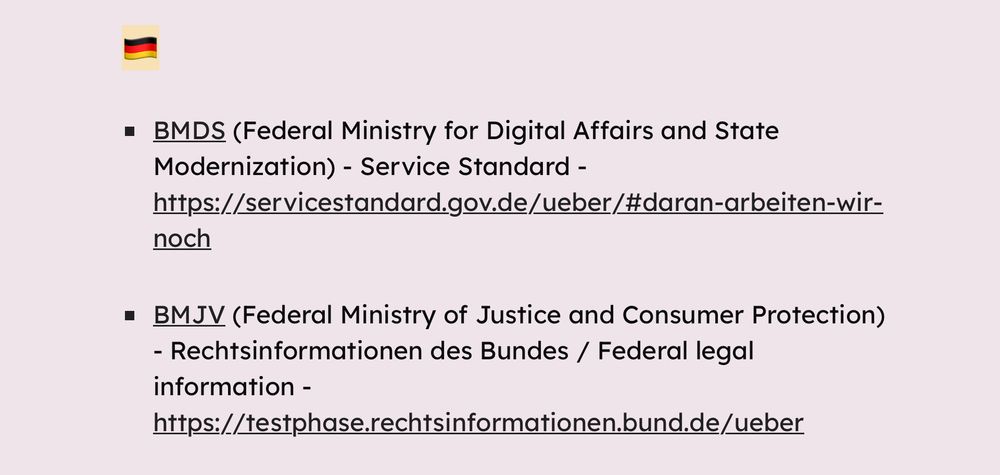
Two links under a German flag emoji:
BMDS (Federal Ministry for Digital Affairs and State Modernization) - Service Standard
BMJV (Federal Ministry of Justice and Consumer Protection) - Rechtsinformationen des Bundes / Federal legal information
Delighted to see some of our work with open roadmaps listed on @rossferg.bsky.social’s growing reference page.
We couldn’t be in better company.
sites.google.com/view/public-...
11.08.2025 09:38 — 👍 4 🔁 2 💬 1 📌 0
That’s great!
We usually hire from B2 Level German, which is also mentioned in currently open engineering roles. A few UX/UI designers are roughly at that level and use some of their L&D budget to improve it.
However, B2 is tricky for service design roles, as much of the work is in policy space.
11.08.2025 08:00 — 👍 1 🔁 0 💬 1 📌 0
We work in both languages. The organisational default language is English, but a team‘s language is more commonly German.
Depending on who starts in a particular month, we may run an onboarding session in English or German.
I only made an English poster and didn’t even consider making a German one
11.08.2025 06:39 — 👍 1 🔁 0 💬 1 📌 0
YouTube video by Charlie Chaplin
Charlie Chaplin - Final Speech from The Great Dictator
But even more of this.
www.youtube.com/watch?v=J7GY...
10.08.2025 21:36 — 👍 2 🔁 1 💬 1 📌 0
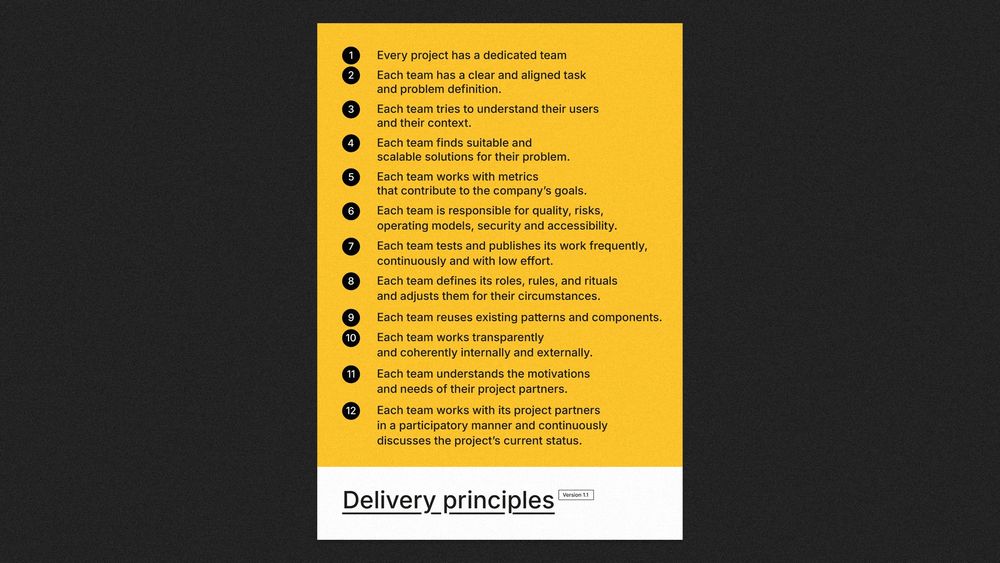
Delivery principles — Version 1.1
1 .Every project has a dedicated team
2. Each team has a clear and aligned task and problem definition.
3. Each team tries to understand their users and their context.
4. Each team finds suitable and scalable solutions for their problem.
5. Each team works with metrics that contribute to the company’s goals.
6. Each team is responsible for quality, risks, operating models, security and accessibility.
7. Each team tests and publishes its work frequently, continuously and with low effort.
8. Each team defines its roles, rules, and rituals and adjusts them for their circumstances.
9. Each team reuses existing patterns and components.
10. Each team works transparently and coherently internally and externally.
11. Each team understands the motivations and needs of their project partners.
12. Each team works with its project partners in a participatory manner and continuously discusses the project’s current status.
Updated on @digitalservice.bund.de’s GitHub repo:
Some months ago, we refreshed our #Delivery Principles after valuable feedback from teams & particularly our product management discipline.
We use them in our onboarding.
Only recently, I refreshed the poster. It’s here: github.com/digitalservi...
10.08.2025 15:24 — 👍 5 🔁 1 💬 1 📌 0
Happy to hear!
I think we still haven’t agreed on the exact term – or have we, @claragt.bsky.social?
10.08.2025 15:21 — 👍 1 🔁 0 💬 1 📌 0
“In Ireland, there are more than 80 data centres, gobbling up 50 per cent of the electricity in the Dublin region, and hoovering up more than 20 per cent nationally, as they work to process and distribute huge quantities of digital information.”
10.08.2025 13:44 — 👍 0 🔁 0 💬 0 📌 0
YouTube video by Verwaltungsgestaltung
Verwaltung schneller digitalisieren: Greta Strutz & Simon Hesse • Creative Bureaucracy Festival 2025
In German:
Beim Creative Bureaucracy Festival sprachen Greta Strutz und Simon Hesse vom @itzbund.bsky.social darüber, wie sie ›Verwaltung schneller digitalisieren‹. Das beinhaltet ein #DesignSystem mit Fokus auf #Barrierefreiheit und neue menschzentrierte Prozesse.
Nun ist der Vortrag auf YouTube:
10.08.2025 08:50 — 👍 2 🔁 2 💬 0 📌 1
That’s more my type of type! Fresh take on Akzidenz-Grotesk—I like!
The numbers are so distinct.
09.08.2025 22:49 — 👍 2 🔁 0 💬 0 📌 0

That’s So Meta
How a font once rejected by the German Post Office defined the digital age, Herman Miller, and type titan Erik Spiekermann.
The origin story, as recorded by @adrianshaughnessy.bsky.social for Herman Miller’s Idea Magazine, adds more to the picture of how the typeface came about—and how the commissioners at the German Federal Post Office received it at the time.
Great to read about the scientific legibility research, too
09.08.2025 14:59 — 👍 4 🔁 1 💬 1 📌 0
Credit where it’s due: Prototype shown by @joseernestorodriguez.com
09.08.2025 14:35 — 👍 1 🔁 0 💬 0 📌 0
Great nerdy knowledge. Thanks for sharing!
09.08.2025 14:32 — 👍 2 🔁 0 💬 1 📌 0

Week #171 at the Digital Service: Notes for 4–8 August 2025
In week 171, Martin helped sketch and prototype a unified service experience across touchpoints, including various basic components. He also worked on the first peer review report against the new Serv...
As a public servant, I write weekly notes to let people see what I do.
In my week 171 at @digitalservice.bund.de, I helped sketch a unified service experience across touchpoints, including various basic components.
I also worked on the first peer review report against the new #ServiceStandard.
09.08.2025 14:29 — 👍 3 🔁 0 💬 1 📌 1
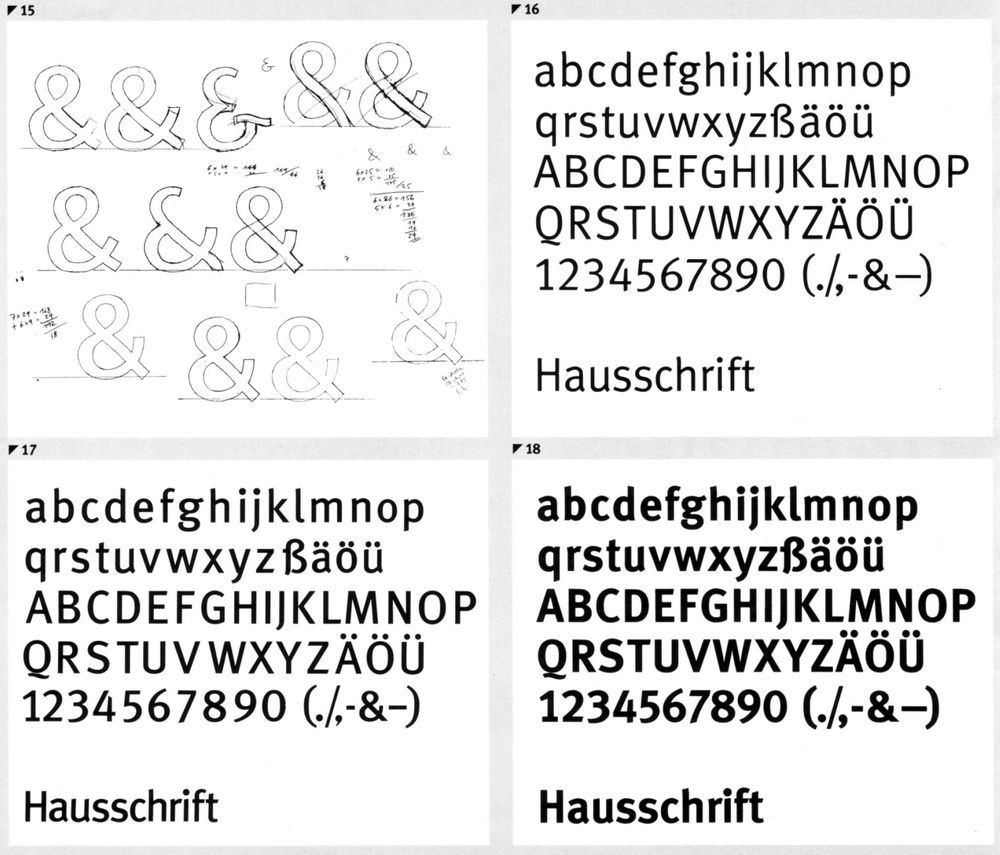
Four panels showing design sketches and variations of the ampersand symbol and Hausschrift typeface in different weights and styles, including lowercase, uppercase, numbers, and special characters.
There is more about ‘PT 55’ – the predecessor of both ‘Fira Sans’ and ‘FF Meta’ – in this article from the magazine ‘Baseline’ from 1986. It describes the making of ‘PT 55’:
spiekermann.com/en/wp-conten...
09.08.2025 13:45 — 👍 2 🔁 0 💬 1 📌 0
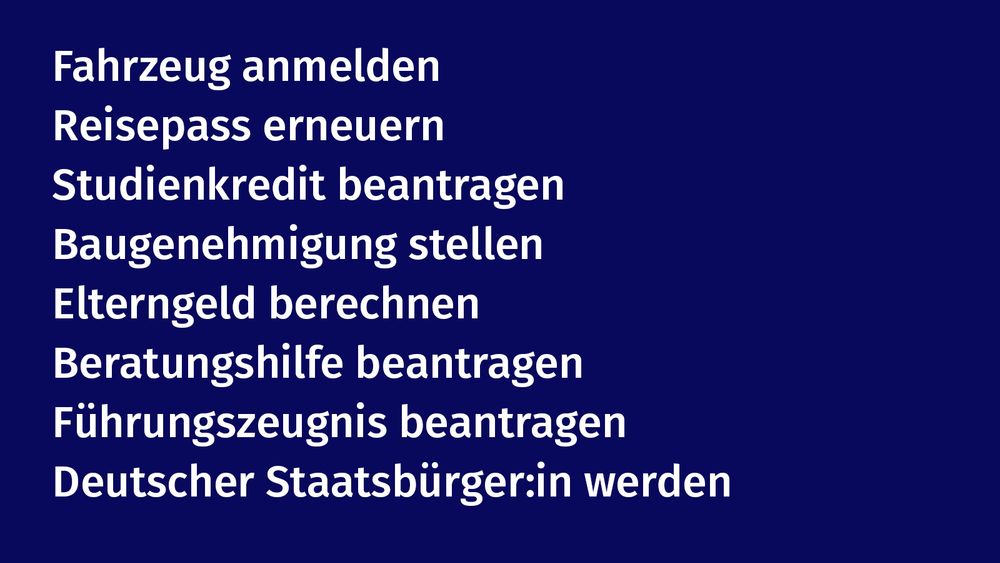
Government services listed: Register a vehicle, Renew your passport, Apply for a student loan, Apply for a building permit, Calculate parental allowance, Apply for legal aid, Receive a police record, Become a German citizen
Using it for government communication and interaction with citizens and residents connects to the brief designer Erik Spiekermann received then.
Back then, the German Federal Post Office was a state-run postal service and telecommunications business.
The font was made for legibility.
09.08.2025 12:50 — 👍 2 🔁 0 💬 1 📌 0
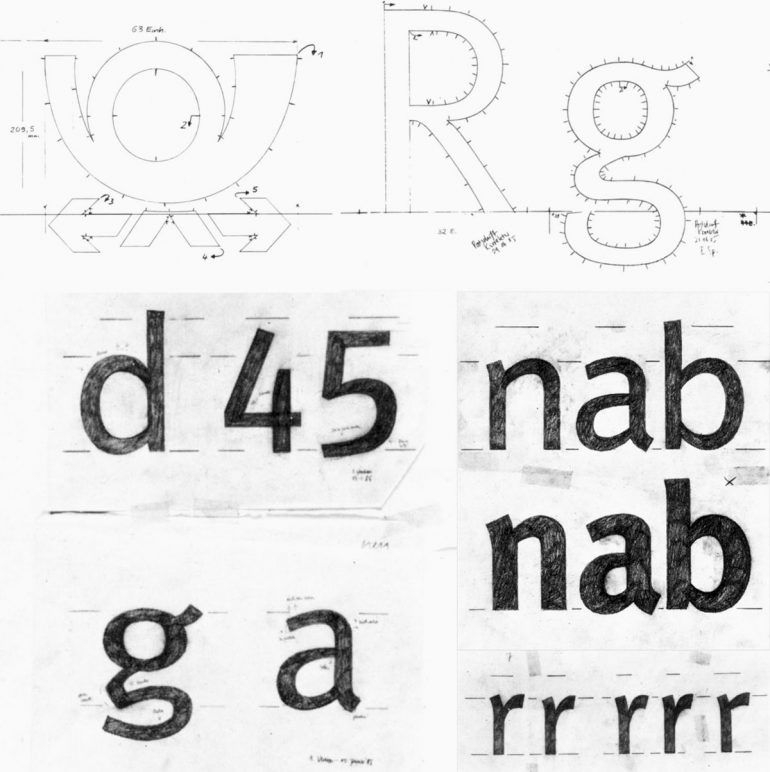
Black-and-white sketches of typeface designs showing letters, numbers, and symbols with construction lines, measurements, and annotations for typography development; including a post horn, symbol of the German Federal Post Office
I’m not the greatest fan of ‘Fira Sans’ as a #typeface.
But as it is used now as font for Germany’s cross-government #designSystem, it brings things full circle.
‘Fira’ is based on ‘FF Meta’, commissioned initially for the German Federal Post Office in 1984 as a “neutral, space-saving typeface”.
09.08.2025 12:50 — 👍 17 🔁 3 💬 1 📌 1
Things aren’t measured, things are duplicated, and there’s little collaboration between parts of the public sector.
The German Federal Court of Auditors (BRH) publishes a harsh review of the state of digital.
It suggests 3 things covered in the #ServiceStandard: measure, collaborate and reuse
✨
07.08.2025 16:58 — 👍 3 🔁 0 💬 0 📌 0
Product designer living and working in Vienna. Kicked PDF SDK UI standards up a notch, improved regulated software development tools, helped friends create Audio Plugins and Synths and drew hundreds and hundreds of icons in the process.
Unlocking the potential of products and services
Designer, writer, educator, publisher, culture zealot. Find me at www.shaughnessyworks-prints.com
Professor for Motion Graphics at the Fachhochschule Potsdam.
Potsdam University of Applied Sciences;
motion graphics – augmented reality – immersive media.
»And let us, ciphers to this great accompt, On your imaginary forces work«
www.fh-potsdam.de/design
does things with words
joannawalsh.ie
writer/artist/msca postdoctoral fellow
Founder/organiser of beyond tellerrand (@beyondtellerrand.com). Co-Founder of Smashing Conference.
Exploring the American idea through ambitious, essential reporting and storytelling. Of no party or clique since 1857. http://theatlantic.com
Climate and culture, inspired by nature 🌍
Magazine, podcast, newsletters, features, and more. ↓
https://atmos.earth/
The latest pop culture news — mostly movies, TV, video games, and social media 🎥🎮
Join our discord discord.gg/culturecrave | subscribe to our newsletter culturecrave.co 📩 | email info@culturecrave.co |
Seit 10 Jahren der Podcast rund um die Themen der Verwaltungsdigitalisierung.
#digvw #blueskyverwaltung #digitalisierung #verwaltung #amt #behörde
Filmmaker, husband, friend to dogs and cats. Creature Commandos debuts on Max Dec 5. Superman in theaters July 11, 2025.
Die einzige nur von Björn Höcke anerkannte Terrororganisation. Werde jetzt Kompliz:in! Wir machen für Dich Stress und radikalen Humanismus: https://werde-komplizin.de
(he/him) Editorial Director & Associate Curator at @letterformarchive.org in San Francisco. Cofounder of @fontsinuse.com & @typographica.org.
Primarily on Mastodon: https://mstdn.party/@stewf and https://typo.social/@typographica
https://stephencoles.org
Maire de Paris, ville hôte des Jeux Olympiques et Paralympiques 2024
Semantics, content, digital identity and weightlifting. Data protection and minimisation are hills I'm happy to die on.
46 countries working together to promote
#HumanRights
#Democracy
#RuleOfLaw
Dieser Account des ZDF wird aktuell noch nicht bespielt. Ihr findet uns bis dahin auf Mastodon, Instagram, TikTok, LinkedIn oder Facebook. (Stand Januar 2025)









